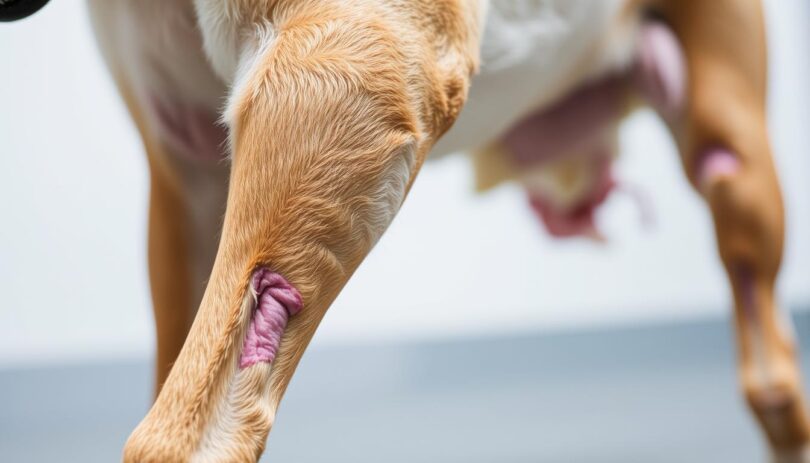Over 20% of veterinary visits involve musculoskeletal issues in pets, with limping being one of the most common concerns. This subtle symptom often masks problems ranging from minor sprains to life-threatening conditions. Recognizing changes in mobility early can prevent long-term health complications for your furry companion.
Since pets can’t verbally communicate discomfort, owners must interpret physical cues. A sudden limp might stem from injuries like fractures or foreign objects in paws. Gradual lameness could signal arthritis, hip dysplasia, or neurological disorders. Each scenario requires distinct approaches for diagnosis and care.
This guide explores potential triggers for mobility changes, from everyday accidents to chronic illnesses. You’ll learn to differentiate between “wait-and-see” situations and emergencies demanding immediate veterinary attention. Clear indicators like swelling, refusal to bear weight, or whimpering warrant urgent professional evaluation.
Understanding these nuances empowers pet parents to make informed decisions. With actionable strategies and preventive measures, you’ll gain confidence in supporting your canine’s well-being while avoiding unnecessary panic.
Recognizing the Signs: When Limping Becomes a Concern
Spotting changes in your canine companion’s mobility starts with careful observation. Subtle shifts like uneven weight distribution or reluctance to play often hint at deeper issues. Owners should track patterns—does the limp worsen after exercise or improve with rest?
Observing Movement Patterns
Watch for irregularities in stride length or rhythm. A pet avoiding pressure on a specific limb might hop or pause frequently. Stiffness when rising, hesitation on stairs, or reduced activity levels can signal joint discomfort or soft tissue injuries.
Assessing Severity
Visible swelling, warmth around joints, or audible whimpers demand immediate attention. Refusal to bear weight for over 24 hours often indicates fractures or ligament tears. Persistent licking at paws may reveal embedded debris or infections needing treatment.
Timely action prevents minor injuries from becoming chronic conditions. Documenting symptoms helps veterinarians pinpoint causes faster, ensuring tailored care plans. Next, we’ll explore how these signs connect to specific health challenges.
Exploring the Common Causes of Dog Limping
Pet owners often notice mobility changes before identifying specific triggers. From everyday hazards to age-related wear, multiple factors can affect a companion’s gait. Early recognition of these causes helps prioritize care and improves outcomes.
Paw Injuries, Foreign Objects, and Infections
Thorns, glass shards, or ice melt crystals frequently lodge between paw pads. These irritants force pets to shift weight unevenly. Untreated debris may cause infections, leading to redness and discharge within 48 hours.
Bacterial or fungal growth between toes often results from moisture trapped in fur. Regular paw checks after walks help catch issues early. Vets typically remove objects under sedation and prescribe antibiotics if needed.
Joint, Bone, and Ligament Conditions
Chronic conditions like osteoarthritis develop gradually, worsening stiffness after rest. Dysplasia—abnormal joint formation—commonly affects hips and elbows in larger breeds. Ligament tears often occur during high-impact play.
Diagnostic tools like X-rays reveal fractures or bone abnormalities. Treatment ranges from anti-inflammatory medications to surgical repairs. Physical therapy strengthens muscles around affected joints, improving mobility over time.
why is my dog limping
A change in gait signals it’s time to investigate potential underlying problems. A dog’s limp often stems from diverse sources, making pinpointing the exact trigger vital for effective care. Observing behavioral shifts helps determine whether the issue requires home management or professional intervention.
Subtle signs like reluctance to jump or excessive licking often indicate discomfort. Pain might manifest through trembling, panting, or withdrawal from activities. These cues demand attention, especially if they persist beyond 24 hours.
Consulting a vet ensures accurate diagnosis through physical exams or imaging. Conditions like fractures, infections, or joint diseases require tailored treatments. Delaying assessment risks worsening the problem and prolonging recovery.
Owners should document symptoms—onset timing, affected limbs, and activity changes. This information guides veterinarians in narrowing down possible causes. Upcoming sections will detail how sudden versus gradual limping impacts diagnosis and care strategies.
Assessing Sudden Versus Gradual Onset of Limping
Determining whether a pet’s limp developed quickly or over time is crucial for proper care. Sudden lameness often follows accidents like slips or collisions, while gradual changes typically stem from progressive conditions. Recognizing this distinction guides owners toward appropriate responses.
Understanding Acute Injuries and Trauma
Trauma-related limping usually appears immediately after incidents like falls or rough play. Swollen joints, visible cuts, or yelping when touched signal acute injury. These cases often require urgent evaluation to rule out fractures or dislocations.
Chronic issues like joint disease manifest differently. Stiffness that eases with movement or intermittent limping over weeks suggests degenerative conditions. Owners might notice reduced interest in walks or difficulty climbing stairs before visible gait changes.
Severe symptoms demand emergency care. If your companion refuses to put weight on a limb for over a day, shows extreme swelling, or exhibits fever alongside limping, contact a vet immediately. Delaying treatment risks permanent damage.
While awaiting professional assessment, restrict activity and prevent jumping. Apply cold compresses to swollen areas for 10-minute intervals. Avoid pain medications unless prescribed, as some human drugs harm animals. Documenting symptom progression helps veterinarians prioritize diagnostic tests.
The Role of Veterinarians in Diagnosing Limping
Veterinary expertise transforms vague symptoms into actionable diagnoses. During consultations, professionals systematically assess mobility issues through structured evaluations. This process begins with observing gait patterns and progresses to targeted tests, ensuring no potential cause goes overlooked.
Physical Examinations and Diagnostic Imaging
Veterinarians start by palpating limbs and joints to detect swelling, heat, or tenderness. They check paw pads for foreign objects and assess range of motion. Over 65% of clinics use X-rays as their primary imaging tool to spot fractures or joint abnormalities.
Blood tests help identify infections or systemic diseases contributing to lameness. Conditions like Lyme disease often show elevated white blood cell counts. These diagnostics clarify whether limping stems from acute injuries or chronic illnesses needing long-term management.
Advanced cases may require MRI scans or synovial fluid analysis. Physical therapy recommendations often follow these assessments to restore mobility. Trusting veterinary guidance ensures accurate differentiation between minor sprains and severe ligament tears, paving the way for effective treatment plans.
Home Care Tips: Managing Your Dog’s Pain and Mobility
Effective home care plays a vital role in supporting pets with mobility challenges. Start by creating a quiet recovery space with soft bedding to encourage rest. Limit stair use and jumping for at least 48 hours to prevent aggravating injuries.
Monitor activity levels closely during recovery periods. Short leash walks help maintain muscle tone without overexertion. Avoid high-impact play like fetch or roughhousing until mobility improves.
Maintaining proper weight reduces joint strain significantly. Excess pounds add pressure to hips and knees, worsening discomfort. Consult your veterinarian about tailored diet plans if weight management becomes challenging.
Track symptom progression using a journal or mobile app. Note changes in gait frequency, stiffness after naps, or reluctance to move. Persistent issues lasting over two days warrant professional evaluation.
While home strategies provide temporary relief, they don’t replace veterinary care. Schedule an appointment if limping continues despite rest or if new symptoms emerge. Early intervention often leads to better treatment outcomes.
Advanced Treatments: Medications, Surgery, and Therapies
When rest and basic care don’t resolve mobility issues, advanced interventions become essential. Veterinarians may recommend tailored approaches depending on the severity and cause of discomfort. These methods range from minimally invasive procedures to specialized rehabilitation programs.
Tailored Interventions for Lasting Relief
Surgery often becomes necessary for severe ligament tears or joint instability. Procedures like TPLO (tibial plateau leveling osteotomy) stabilize knees in active canines. Fractures may require pins or plates to ensure proper healing. Always follow post-operative care guidelines to prevent complications.
Non-surgical options include NSAIDs prescribed by veterinarians to manage pain and inflammation. These medications work best when combined with rest and controlled activity. Never use human pain relievers without professional approval.
Hydrotherapy and acupuncture gain popularity as complementary treatments. Water-based exercises reduce joint stress while building muscle strength. Acupuncture targets pressure points to improve circulation and ease chronic discomfort. Some clinics also offer chiropractic adjustments to correct spinal misalignments affecting mobility.
Physical rehabilitation programs focus on restoring range of motion through targeted exercises. Underwater treadmills and balance boards help pets regain coordination safely. Consistent therapy sessions often accelerate recovery by 30-40% compared to rest alone.
For ligament injuries, vets might suggest braces or supports during healing. Combined with gradual reintroduction to activity, these tools prevent re-injury. Always consult specialists to create a multi-faceted plan addressing your companion’s unique needs.
Preventive Measures to Protect Your Dog’s Joint Health
Proactive care significantly reduces joint problems in canines, enhancing their quality of life. Maintaining healthy joints requires consistent effort through diet, activity adjustments, and professional oversight. Early intervention helps manage conditions like arthritis before they severely impact mobility.
Weight Management and Exercise Moderation
Excess weight strains joints, accelerating wear in hips and legs. Studies show overweight dogs develop osteoarthritis twice as often as lean pets. Balanced nutrition and portion control prevent obesity-related stress on cartilage.
Low-impact activities like swimming strengthen muscles without jarring movements. Avoid repetitive jumping or long runs on hard surfaces. Tailor exercise routines to your companion’s age and breed, especially for those prone to hip dysplasia.
Routine Veterinary Checkups
Annual exams detect subtle joint changes through palpation and gait analysis. Blood tests identify inflammation markers linked to arthritis. Vets may recommend joint supplements or X-rays for high-risk breeds.
Early-stage dysplasia often shows no visible symptoms but appears on imaging scans. Addressing issues before limping develops improves treatment success rates. Consistent monitoring ensures timely adjustments to care plans as pets age.
Lifestyle Adjustments: Supporting Your Dog’s Long-Term Recovery
Helping a pet regain mobility involves more than temporary fixes—it requires thoughtful daily adjustments. Successful recovery from chronic joint issues or ligament injuries depends on consistent routines that balance rest with strategic activity. Owners play a critical role in creating environments that promote healing while preventing setbacks.
Structured Routines for Lasting Wellness
Controlled exercise plans prevent overexertion during rehabilitation. Start with five-minute leash walks three times daily, gradually increasing duration as strength improves. Avoid sudden movements or rough play that could strain healing tissues.
Nutrition directly impacts recovery speed and joint health. High-quality proteins support muscle repair, while omega-3 supplements reduce inflammation. Consult your vet about calorie-controlled diets if weight management becomes necessary—excess pounds add stress to vulnerable joints.
Home modifications minimize injury risks. Non-slip rugs improve traction on hardwood floors, and ramps replace stairs for pets with hip issues. Designate quiet resting areas away from high-traffic zones to encourage downtime.
Regular veterinary checkups track progress and adjust care plans. Many owners report faster improvements when combining prescribed treatments with monitored activity increases. Documenting mobility changes helps identify patterns needing professional attention.
Final Reflections on Caring for a Limping Dog
Mobility challenges significantly impact a pet’s quality of life, making timely action essential. Early detection of limping dogs often prevents minor injuries from escalating into chronic conditions. Whether facing sudden accidents or progressive joint disease, understanding the root cause guides effective care strategies.
Limping dogs may show improvement through rest and home care for minor paw injuries. However, persistent lameness often signals deeper issues like ligament tears or Lyme disease. Conditions like osteoarthritis require long-term management through weight control and tailored exercise.
Create a symptom checklist: swelling lasting over 24 hours, refusal to use a limb, or fever paired with limping. These red flags demand immediate veterinary consultation. Even subtle changes in leg movement warrant attention if they recur frequently.
Successful outcomes blend preventive measures with professional care. Regular paw inspections reduce foreign object risks, while routine checkups catch early signs of joint deterioration. Trust your veterinarian’s expertise when injuries don’t resolve with basic first aid.
With patience and proper treatment, most pets regain comfortable mobility. Stay observant, act promptly during emergencies, and celebrate small improvements in your companion’s journey toward recovery.
FAQ
What emergency signs indicate immediate veterinary care for limping?
Seek urgent care if limping accompanies swelling, open wounds, inability to bear weight, fever, or sudden collapse. These may signal fractures, severe infections like Lyme disease, or internal bleeding requiring prompt intervention.
Can minor limping resolve without medical treatment?
Mild limping from muscle strains or small cuts often improves with 24–48 hours of rest. However, persistent issues beyond two days or worsening mobility warrant a vet visit to rule out ligament tears or joint disease.
How do paw injuries contribute to limping?
Cracked pads, lodged debris (e.g., thorns or glass), and bacterial infections cause discomfort. Regularly inspect paws for redness, foreign objects, or unusual odors. Use pet-safe antiseptics for minor wounds and consult veterinarians for embedded materials.










Leave a Comment